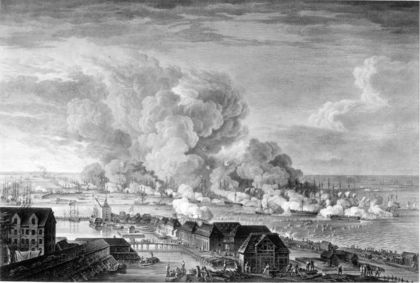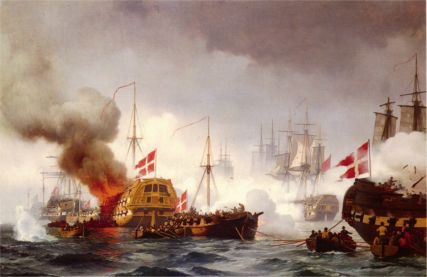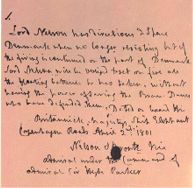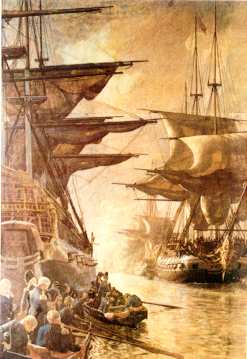|
You are here: 4Campaigns & Battles4Index4The British Wars |
|||||||||||||||||||||||||||||||||||||||||||||||||
|
The British Wars (1801-1814):
Great Britain's
|
||||||||||||||||||||||||||||||||||||||||||||||||
|
Lord Nelson's letter to the Danish
Government - a clever trick |
Lord Nelson disobeyed the order to retreat from battle, instead he issued the order to continue. Simultaneously he wrote a letter addressed to the Danish government. Amongst the demands in this letter, Lord Nelson promised that he would spare the captured Danish sailors, should the resistance and battle be brought to an end. If not he would show no mercy and burn all the captured ships. Hereby leaving no chance of saving the defending sailors on board. Nelson later on claimed the letter was written out of his human compassion. But in reality it was a clever trick. |
This is simplified by one fact alone! At the time when the letter was written, not a single Danish ship had been conquered by the British.
In fact 3 of the British warships was getting dangerously close to the Danish land based battery TREKRONER, Lord Nelson needed to end the battle.
How a modern war crime commission would judge Lord Nelson's threat of burning up ship and personnel I will leave for the expertss to decide. - But the Geneva Conventions had yet to be invented!
Arms treaty and 6 years of peace
|
Captain, |
It was 3 o'clock in the afternoon when the Crown Prince of Denmark-Norway received Lord Nelson's letter. In his judgment, to continue the battle was useless and he gave the order to seize firing. It is however worth to taking of another fact! This decision was taken without consulting the military commander J. Olfert Fischer. An armistice had been established. The British had hereby achieved the goal in forcing Denmark-Norway to leave the neutrality pact. On the opposite side Denmark-Norway succeeded in defending Copenhagen and saving the navy - this time! Many vessels from the Danish-Norwegian trade fleet had during the conflict been captured by the British and were now released. Soon after they were sailing the seas again. |
Denmark-Norway continued to stay neutral but this time without allies, for a short period of time trade flourished again.
Dark skies ahead
In the beginning of 1807 Denmark-Norway was more or less the only neutral country left in Europe.
This Situation becoming more and more impossible and made even worse impossible by restrictions forced upon neutral trade by the war parties.
Fearing that the Danish-Norwegian naval fleet would fall into the hands of Napoleon, Great Britain planned yet another attack on the still neutral Denmark-Norway.
The British plan was to take by force the Danish-Norwegian naval fleet and bring it into their hands. In other words to steal it.
In July, 1807 the British shipped out the second attack fleet against Demark-Norway.
Not only were the force of the attack fleet this time double the size of the first one but this time they brought a large invasion force with them.
The British now bringing an attack fleet of 24 warships and 22 smaller vessels. In addition to the fleet a large number of transport vessels.
In all the British had taken the necessary equipment with them containing 30,000 men, horses, artillery etcetera.
In response to this massive threat of terror hanging over their heads Denmark-Norway did not give in to the demands of Great Britain.
In the end and very important! - It was not until after the two attacks by the British, that Denmark-Norway were left to choose sides in the all European conflict.
By then the British had repeatedly attacked the kingdom and Denmark-Norway had only one side to choose and that was the side of Napoleon.
Copenhagen under siege
Instead the people of Copenhagen had to improvise and prepare for yet another war against the British within just a few years.
As in 1801 most of the Danish-Norwegian naval fleet were in dock unprepared for the war, only a few of the warships were fully equipped. commander Steen Bille was appointed as chief of the naval defense, while Copenhagen's military chief in command, General Ernst Peymann would lead the land based defense.
August 16, 1807 the Danish army concentrated on the defense of the capital, leaving the British free to land their main forces at Vedbæk.
Within days the British army were placed facing Copenhagen in going north to south.
Copenhagen was now a besieged city!
Two attempts to make Denmark-Norway give up and hand out the naval fleet were made on September 1st and 2nd, before commencing battle.
The demands were unacceptable to the Danes so they turned the British down.
4 days and nights full of terror
Close to eight o'clock evening time the British began to bombard Copenhagen deliberately aiming for large public buildings churches etc in order to set the city on fire.
The first bombardment lasted close to 12 hours, the result was a huge loss in the city's civil population and civil buildings.
The British were trying out their new Congreve fire rockets!
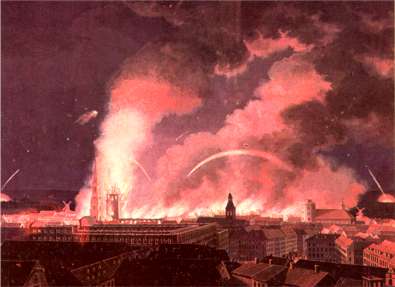
Early morning September 5 one of Congreve
fire rockets sets the tower of the Cathedral of Copenhagen on fire. Being one of the buildings the British were
deliberately aiming at, it eventually collapsed and burnt down completely.
After 3
days and nights of aiming "Well done, old chap "
The following nights, this bombardment was to continue with the same ruthlessness and an increasing force.
Finally in the morning of September 5, the British succeeded and managed to hit the tower of Copenhagen's Cathedral ("Vor Frue Kirke") and set it on fire.
For 3 days and nights the British had been aiming to hit "Our Lady's Church" and it must have brought them tremendous satisfaction when they finally did.
(In comparison it would be the same if the Danes were outside London trying to set St. Paul's Cathedral on fire!)
When the tower of the Cathedral broke down in the fire, it fell down upon the rest the church and increased the fire. Leaving no chance for the firemen and civil rescue workers and the Cathedral burnt out totally.
Large fires already developing in the inner circle were now becoming one single huge fire. Firemen and ordinary men trying to extinguish the fires had been working several days in a row and by this time they were simply exhausted.
Only by extreme extraordinary effort was it possible to save the priceless book collection belonging to the University of Copenhagen, which were stored in the attic of the church.
The atmosphere of the whole situation was becoming more and more hopeless and negotiators were sent out to the British in the hope of a truce or a pause in the bombardment.
Negotiations began but the British demanded a total unconditional surrender and that the whole Danish-Norwegian Navy be handed over to them.
Finally Copenhagen gave up and surrendered.
|
The Great Robbery September 6, 1807, General Ernst Peymann, the Danish Chief-in-Command, surrendered the city and the terms of capitulation were as following:
The British now invaded the areas they had forced their way into and cleverly keeping within those areas. Thereby avoiding new conflicts with the city's civil population who had endured and suffered so much. The British spent the following 6 weeks preparing the stolen navy to sail of to Britain. October 21, they set the sails and took with them 16 ships-of-the-line, 15 frigates and Corvettes, 14 smaller vessels. Makes one wonder how the British Navy became the worlds largest... |
October 21 became a day of sorrow for
the Danish-Norwegian naval fleet when the main part of it left Copenhagen. |
Other than the naval ships they took 92 trade ships loaded with naval materiel
Besides removing more or less everything they could load on the ships. Everything they could not take away was destroyed, according to records they also performed an incredible vandalism every where they went.
Denmark-Norway had taken a tremendous blow and totally lost in all the aspects of being able to protect its trade as well as maintaining the territorial seaways.
Denmark-Norway was totally and utterly against its will being forced out of neutrality and into war quite naturally on the French side.
Sweden the former ally that never fulfilled any of the obligations to Denmark-Norway saw its largest interest of making a new alliance with the British.
Gunboats and guerilla warfare at sea
The loss of the navy can only be described with one word! It was catastrophic for Denmark-Norway, there was neither time, economics or enough oak trees to build a new navy.
Therefore the decision was made to put all efforts into the building of smaller gunboats in large numbers. The advantages in the gunboats were that they could be built fast in large numbers and in every part of the country.
Another was that they could be placed all over the country along the coastlines where they would sit and wait fishing for the British convoys to pas by.
Guerilla warfare at sea had begun.
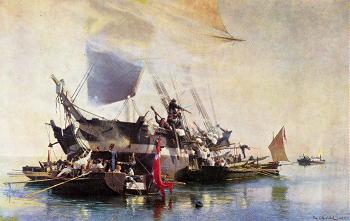
British ship under attack by Danish-Norwegian gunboats.
(Painting by Chr.
Mølsted - Royal
Danish Naval Museum archives)
In June, 1808, gunboats succeeded in capturing the first two British war ships, the TICKLER and the TURBULENT.
While the navy were mass producing gunboats, piracy was now made legal.
King Frederik VI sent out rules of engagement and now any one could be granted Caper rights, set sail and claim any enemy ships to be Danish-Norwegian.
During the war 1807-1814 a total of 10 British warships and quite a large number of trade ships were taken by these gunboats.
The last great ship-of-the-line
One single Danish ship-of-the-line, the PRINDS CHRISTIAN FREDERIK, had avoided being handed over to the British, as the ship was in Norway in 1807, thereby it was the last of the major warships of Denmark-Norway.
During the spring of 1808 it was needed to protect the sea transfer of a French-Spanish army sent to assist Denmark-Norway, and the PRINDS CHRISTIAN FREDERIK, commanded by Captain C. W. Jessen was ordered to protect army while it was crossing the sea.

The
PRINDS CHRISTIAN FREDERIK's
last fight.
(Picture from the Royal
Danish Naval Museum archives)
As the ship were soon to be spotted by British ships at Sejerø in the southern part of Kattegat, Captain C. W. Jessen could see himself out numbered by the British force of at least 2 major warships and 3 frigates.
Instead of leading the British towards the army that were in middle of crossing the Great Belt, Jessen changed his course away from the troops and up towards Sjællands Odde.
While darkness came crawling on the evening March the 22 1808, the last Danish-Norwegian major warship began a long and bitter fight to the end against the British Ships.
After several hours of battle the PRINDS CHRISTIAN FREDERIK was set to rest on a sandbank while the ship was burning and later exploded, the flag was stricken. Among others of the fallen was one of the great heroes from the battle of Copenhagen Roads, 1801, Lieutenant Peter Willemoes.
NAJADEN's fight became the last major fight
The last major fight between Danish and British men of war happened on July 6, 1812.
The Danish-Norwegian frigate NAJADEN, and the brigs LOLLAND, KIEL and SAMSØE had taken refuge in a Norwegian fjord close to Lyngør, due to bad weather.
The Danish ships were here taken by surprise by the British ship-of-the-line DICTATOR and the brig CALYPSO, as these ships in an unaccountable manner had been piloted into the narrow Norwegian Fjord. - Treason was mentioned, but never verified.
After more than one and a half hours fierce fighting the captain of the NAJADEN, commander H. P. Holm, had to make a report to his king, saying: "It is my hard and humble duty to inform Your Majesty, that the frigate NAJADEN is no more".
The concluding remarks in this report also gives an apposite characterization of the combined Danish-Norwegian efforts during the wars against Britain 1801 and 1801 thru 1814:
"However dreadfully sorry I am over the loss of Your Majesty's ship NAJADEN, it would be highly unfair by me, not to mention the great dedication devoted to serve Your Majesty shown by all officers and hands on board, and the most resolute courage to defend the honor of the colors".
Norway became the price for peace
When the peace was settled in Kiel during the night of January 14 and 15, 1814, it brought an end to the more than 300 years old union between Denmark and Norway, and the era of the Danish-Norwegian naval power was finally ended.
Already on the following day, January 16, King Frederik VIth wrote: "I wished, I had never seen this grievous day, where I was forced to give the admission, that Norway, my dearest Norway, should be the sacrifice given for not dismissing everything".
But King Frederik VIth had no alternatives. Militarily he had his back to the wall, and the Swedish King Karl Johan demanded the surrender of Norway as a condition for peace.
Norway, however, did not intend to accept this peace settlement, and the Norwegians started preparations for the defense of Norway. At the same time the Norwegians prepared an independent Constitution.
The new Norwegian Constitution was instituted May 16, 1814, but just 13 days later, May 29, the country was invaded by Swedish troops. Despite glorious and fierce resistance, the Norwegians had to sign an armistice August 8, 1814.
During the following peace negotiations it was agreed, that Norway should hold its independence in a union with Sweden, and that the Swedish king Karl Johan was to become King of Norway.
The united kingdom of Denmark-Norway had been separated for good.
Epilogue
Today you will find a great number of oak trees in the Danish Forests, ready for the building of major warships.
This is the result of a long term planning, appropriated in 1807, when it was decided to plant more than 90,000 oak trees for future shipbuilding.
Unfortunately, oak trees are no longer needed for shipbuilding.
|
Sources: |
||
|
& |
De så det ske - ENGLANDSKRIGENE 1801-14, by Lars Lindeberg, Lademann Forlagsaktieselskab, Copenhagen 1974 |
|
|
& |
ORLOGSMUSEET - Introduktion til Flådens historie, by Ole Lisberg Jensen, Royal Danish Naval Museum, Copenhagen 1994 (ISBN 87-89322-14-2) |
|
|
& |
SLAGET PÅ REDEN, by Ole Feldbæk, Politikens Forlag (1st Edition, 2nd print), Copenhagen 2001 (ISBN 87-567-4001-8) |
|
|
& |
SØKRIGEN i de dansk-norske Farvande 1807-14, by C. F. Wandel, Copenhagen 1915 |
|
|
44You are also referred to the Naval Bibliography |
||
![]()
- Do you miss a major event on this Site,
or do you hold a great story?
Are you able to contribute to the unfolding of
the Danish Naval History,
please
e-mail
me, enclosures are welcome.
Please remember to list your sources.
You can also use the Naval Web Forum on this web-site.
![]()
|
MORE IN-DEPTH STORIES FROM |
|
The Battle at The West Kay (1801) - The Rape of the Danish Navy (1807) - |
|
SEE ALSO: |
|
THE TOPIC STORIES: |
|
- Wars against England (1801-1814) - Reconstructing the Navy (1814-1848) - The 1st Schleswig War (1848-50) - The interim War Years (1850-64) - The 2nd Schleswig War (1864) - The long Period of Peace (1864-1914) - The Navy during the 1st World War (1914-1918) - The Interim Years (1919-1939) - The Navy during the 2nd World War (1939-1945) - The Cold War Period (1945-1989) - |
-
This page was last updated: -
This page was first published: April 22, 2003
Copyright © 2013-2016 Johnny E. Balsved - All rights reserved - Privacy Policy


